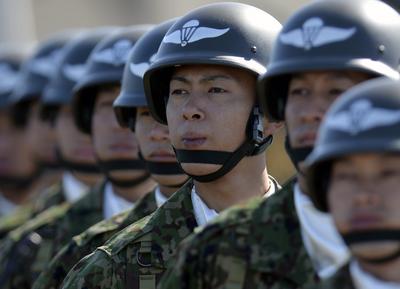Later on the same day, Abe announced in a televised press conference that he would seek to reinterpret the Japanese constitution to make it possible for his country to start exercising the right of collective self-defence. If this is achieved, Japan’s Self-Defense Forces (SDF) will be able to defend not only Japan but also other countries in the Asia Pacific region.
An important objective of constitutional reinterpretation is to maintain the balance of power in the region in the face of China’s rise. According to the Stockholm International Peace Research Institute (SIPRI), China’s defence expenditure has grown by 170 per cent in the past ten years. In contrast, the US defence budget has increased only by 12 per cent in the same period, and much of it has gone to its war efforts in Iraq and Afghanistan. In the past decade, Japan’s defence expenditure has declined by 0.2 per cent.
An effective way to maintain balance in the region would be to create a broader regional security network involving a larger number of partners, namely South Korea, Australia, India and Southeast Asian countries. The SIPRI data indicates that some of these countries are strengthening their defence capabilities. India’s defence expenditure has grown by 45 per cent in the past decade; South Korea’s by 42 per cent; and Australia’s by 19 per cent.
In this new regional security network, the SDF would be likely to operate closely with US, Australian, Southeast Asian and Indian forces, and Japan would establish full-fledged strategic partnerships with these countries. Collective self-defence would open the door for Japan to actively contribute to such a regional security network by allowing the SDF to participate in joint military training and exercises, joint patrol and surveillance activities, intelligence sharing operations, and capacity-building activities with its regional partners. So far, Japan has participated in joint training and exercises only when their purpose was humanitarian.
The idea is to bolster the region’s deterrent capabilities vis-à-vis China by strengthening strategic partnerships among the countries in the region. Shigeru Ishiba, the ruling Liberal Democratic Party’s (LDP) secretary general and former defence minister, has suggested that with the right of collective self-defence, Japan could become a part of a regional security network that would look like an ‘Asian version of NATO’.
Although Ishiba probably exaggerated Asia’s ability to establish a well-institutionalised collective-defence mechanism like NATO, Ishiba was right when he said Japan’s efforts are about building a regional security network.
The advisory report recommended legal changes so that Japan could fight back when US naval vessels came under attack and shoot down a missile heading to Hawaii or Guam. These scenarios are important to think about, but they are not realistic. If China is to drive a wedge between the United States and Japan over the Senkaku/Diaoyu islands, for example, it would attack Japanese vessels — not US vessels. In the case of war on the Korean Peninsula, North Korea would attack US bases in Japan before it started attacking those in Hawaii or Guam.
The importance of these scenarios lies primarily in their political persuasiveness. These scenarios are useful in convincing the Japanese people of the need to reinterpret the constitution. If your friend is willing to help you but you cannot reciprocate, what kind of friendship is it?
Despite some speculation, the defence of South Korea is not an important factor in Abe’s push to reinterpret the constitution. Japan’s security commitment to the defence of South Korea will decline as it shifts its attention and resources away from North Korea toward China. Also, South Korea’s enhanced capabilities have made it possible for the country to effectively defend itself against North Korean aggression.
With the right of collective self-defence, Japan could provide ammunition and targeting information to US forces fighting for South Korea. Still, even this is a relatively marginal addition to what Japan has been prepared to do since 2000.
The most important question now is whether the Abe government will be able to garner sufficient support and implement the advisory panel’s recommendation to exercise the right of collective self-defence. The LDP’s coalition partner New Komeito is hesitant to offer its full-fledged support arguing that exercising the right of collective self-defence is not necessary for the defence of Japan.
Many among the Japanese public are also not entirely convinced by Abe. According to an NHK opinion poll conducted in early June, when asked about the exercise of collective self-defence 26 per cent of respondents agreed, the same number disagreed, and 41 per cent remained undecided.
While pushing ahead with reinterpreting the constitution, Japan must deeply consider how it can use the right of collective self-defence effectively. Strong leadership and policy planning are needed, as the ability to exercise collective self-defence on its own will not automatically translate into enhanced security for Japan and the region.
Narushige Michishita is a Professor at the National Graduate Institute for Policy Studies (GRIPS) in Tokyo, where he is the director of the Security and International Studies Programme. His works include North Korea’s Military-Diplomatic Campaigns, 1966-2008 (Routledge, 2010).

